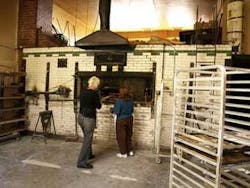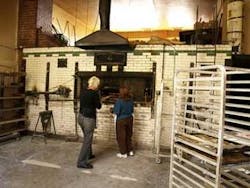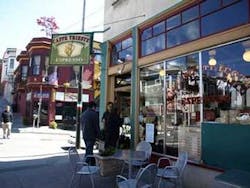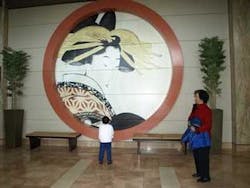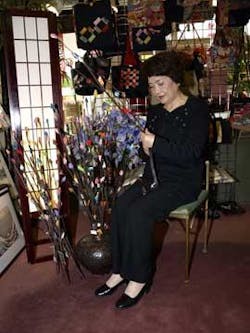San Francisco the Second Time
I'm eating my second chocolate biscotti, a 5" long, perfectly-crisped Italian cookie. I watched as it was pulled out of a 130-year-old brick oven, and I listened as our guide explained why baking biscotti in the right kind of oven makes all the difference in the world.
A few minutes later, I'm dipping a piece of crusty San Francisco sourdough into a bowl of extra-virgin olive oil. I lift it to my mouth, savor it slowly. It has a soft, buttery taste, not at all like the olive oil I sampled a few minutes previously. I learn about the difference in processing and why one is perfect with salmon, the other with salad.
I hadn't intended to become a foodie while touring San Francisco's North Beach, but food and history are intertwined in this section of the city, and you can't learn about one with out learning about the other. Best of all, to learn you have to taste.
Four hours and untold calories later, I'm both sated and smiling. This is the San Francisco I wanted to experience.
My husband and I have been to San Francisco many times, but this is the first time we've delved beneath the surface. We've seen the Golden Gate, walked the crookedest street, shopped Union Square, eaten in Chinatown. Now we've resolved to see it in a new way. We're going to learn from the experts.
North Beach
The American Planning Association calls North Beach one of ten "great neighborhoods in America", and it's easy to see why. It's a community in every sense of the word — a place where people walk, talk and eat.
That's exactly what we do on our award-winning Local Tastes of the City Tour. Tom Medin, owner and guide, begins by giving us the history of the area. It was, he says, settled by Italians, then became a hangout for members of the Beat Generation and a risqué nightclub district. But now it's relaxed into an area of small shops, eateries, bakeries and delicatessens.
He leads us from one to another, feeding us fascinating facts to digest along with the food. By the end of the tour, when we go into Café Trieste, a coffee house frequented by the likes of Steve Allen, Woody Allen, Pavorati and Bill Cosby, I'm feeling like I am an in-the-loop San Franciscan.
That night, to solidify our city-wise credentials, we go to Beach Blanket Babylon, a San Franciso staple for 34 years. We sip wine as we watch performers, often wearing outrageous hats that are four or five feet tall, sing and spoof all things political and most things sacred. The man next to us laughs so hard that he spills wine into my lap. I barely notice because I'm laughing equally hard.
Japantown
I walk into the Kabuki Hotel and feel as if I'm Alice and have just fallen into a Japanese Wonderland. Soft music is playing, a huge picture of a geisha hangs on the wall, the lobby is comfortable but uncluttered.
We go up to our room where, a few minutes later, a man knocks on the door. "Your tea is here, ma'am," he says, with a nod and slight bow. It's a bare-bones tea ceremony, but we get the idea. We've been officially welcomed.
We were offered an authentic Japanese room, one in which the bed was a futon placed on a tatami mat. We debated, but in the end, we'd opted for an American room with Japanese accents. That means our room has a regular off-the-floor bed, but there are screens over the windows and a wall inset filled with Japanese art, just like in Japanese homes.
Best of all, we have a Japanese bathroom. The tub is 19 inches deep, much deeper than my tub at home. There's a small stool next to the tub. A card on the desk explains the bathing ritual: Fill the tub with steaming hot water. Sit on the stool and wash and rinse yourself before getting into the tub. Relax in the tub for five minutes, but don't use soap as it will spoil the water. Get out of the tub, sit on the stool, wash and rinse. Then get back into the tub and soak "to your heart's (and body's) content." This pretty much takes care of our evening entertainment.
The Kabuki Hotel is a member of Joie de Vivre Hotels, California's largest boutique hotel group. One of their signature offerings is the Golden Gate Greeter program in which they match guests with a local person for a personalized tour of San Francisco. We ask for a tour of Japantown, and Tomo, a young Japanese man who's been in the United States for two years, leads us around for two-plus hours.
He walks us through Japan Center, a series of malls filled with a variety of stores and restaurants. In the Kintetsu Mall I spot some beautiful branches of cloth flower buds in the window of Omadaka, a small shop that sells clothes and home decoratives. The owner and craftsperson, Niroko Thuvoi, demonstrates how she makes the small buds out of chirimen, a high quality silk crepe used for kimonos. "Three of these bud branches will look perfect in our living room," I tell my husband. He agrees.
Before we part, Tomo tells us that the Kabuki also offers Saturday cultural programs for hotel guests and, space permitting, for members of the public. People are introduced to different traditional crafts. One week there may be a demonstration of ikebana (flower arranging); the next week, an explanation of the tea ceremony; the following week, a lesson in calligraphy. We vow to attend.
Chinatown
We're walking though San Francisco's Chinatown, but the bustling crowds of Grant Avenue seem far away. Here men are playing mah jong in back rooms, women are folding disks of dough into fortune-cookie packets, and a man is weighing medicinal herbs for a customer who has a hacking cough.
"Nee haw, hello," I say, trying out my one phrase of Chinese.
Our leader — she doesn't like to be called a "guide" — laughs. "No, no, no," she says. "That's Mandarin Chinese. Here in San Francisco, most of the Chinese speak Cantonese. It's nay ho."
That's only the first of many things we learn as we follow Shirley Fong-Torres, aka the Wok-Wiz, through San Francisco's Chinatown. She avoids Grant Avenue as she leads us to the back streets where "real people live, work, and play."
She points to a mural on an alley wall. As she explains it, the scene takes on a new meaning. Without her, we'd have never known that it depicts an activity that takes place only on Chinese New Year.
We walk into a store where there are imitation cell phones, television sets, food and clothing, all made out of paper. The Chinese, we learn, want to make sure their relatives have all the comforts of this world when they journey to the next one. Again, without Shirley, we'd have thought the items were simply cute children's toys.
Financial District We're standing in a small, very small, park atop a tall building in the Financial District. Across from us, almost at eye level, is the Hallidie Building, built in 1917 and one of the world's most architecturally-significant buildings. Our guide, Rick Evans, explains how it was the first building to feature "glass curtain walls" and how it was named in honor of Andrew Hallidie, the inventor of the San Francisco cable car.
We walk a few blocks and find ourselves on another rooftop garden. "These are the hidden treasures of San Francisco," says Rick, the developer of the San Francisco Architecture Walking Tour. Indeed, some of these places are so hidden that they're unknown even to people who work within a few blocks of them.
A few minutes later we stand in one spot and look up at the Shell Building, the last major structure built before the Depression and War halted construction activity. Across the street and reflected in the building's wall is the Crown-Zellerbach building, built in 1959. In those thirty years styles changed from ornamental to functional as the United States moved into its role as a world power.
As we walk through the Financial District on a 1 ½ mile route, we learn to see and understand the city in a new way. Rick is a natural storyteller, and he uses architecture as a guide to history and culture.
Eighty percent of the people who go on Rick's tours are locals. They end up learning more about the city in two hours than they've learned in twenty years.
Nob Hill
We take a cable car to the Fairmont Hotel, the grand dame of hotels atop San Francisco's Nob Hill. It seems apropos since the cable car is what allowed the 19th century most privileged to live in rarefied hilltop air, far above the "low-life" who frequented the docks. The hill was simply too steep for horse-drawn carriages.
Valerie Huff, owner of Hobnob Tours, meets us and leads us first through the public rooms of the grand hotel, then on a two-hour, flat-ground tour of the neighborhood. Before the earthquake of 1906, the area was filled with grand mansions and luxury hotels, all but two of which — the Flood Mansion and the partially-finished Fairmont — were destroyed by the post-quake fires. Today the area is again filled with homes of the affluent.
I drink in both the atmosphere and the gossipy tidbits. I learn, for example, that two feuding barons each hired bodyguards to protect one from the other, and that a rich widow disinherited her son when he opposed her marriage to a younger man.
By the time the tour ends, I know why Nob Hill is sometimes called "snob hill," and I'm reveling in my insider status.
I go back to our hotel, the Palomar, and look at my guidebook. We've only begun to explore the neighborhoods in depth, but for now my mind is full and my feet are sore!
For more information:
North Beach
Local taste of the City Tours with Tom Medin.
415-665-0480 www.localtastesofthecitytours.com
Where to stay: The Hyatt Fisherman's Wharf. 415-563-1234 www.FishermansWharf.Hyatt.com
Rooms are sleek and modern, the staff is extraordinarily knowledgeable and welcoming, and the location couldn't be better. Perfect for business or leisure travel. Tip: Valet parking is good for 24-hours with free in/out privileges. Arrive in late afternoon and have your entire last day to explore the wharf without parking problems.
Japan Town
Hotel Kabuki. 415-614-5401. www.hotelkabuki.com
The personalized tour service is complimentary for guests. Advance notice necessary. Saturday cultural programs are free for both guests and the public. Call for time and topic.
Chinatown
Wok Wiz Chinatown Tours with Shirley Fong-Torres.
650-355-9657. www.wokwiz.com
Financial District
San Francisco Architecture Walking Tour with Rick Evans.
415-264-8824. www.architecturesf.com
Nob Hill
Hobnob Tours with Val Huff.
650-814-6303.
Palomar Hotel. 866-373-4941 or 415-348-1111, www.hotelpalomar-sf.com
Just a few blocks from Union Square, the Palomar is a delightful urban retreat. It's an easy walk to Chinatown and the Financial District, and an easy access to the cable car for a visit to North Beach, Japantown and Nob Hill. First class shopping and restaurants are right outside the door.
In addition to travel writing, Irv and Andrea have founded LEGACY PROSE™, a company that helps people pass on their stories and values to their children and grandchildren. www.legacyprose.com
